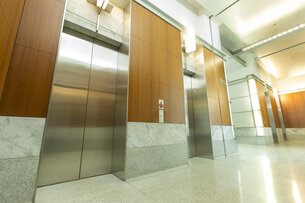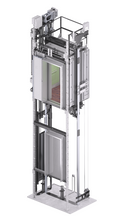ELEVATING TOUCHLESS TECHNOLOGIES
Print this Article | Send to Colleague
NEW ELEVATOR SOLUTIONS OFFER CONVENIENCE AND PUBLIC-HEALTH BENEFITS
BY NICK FORTUNA

In the age of COVID-19, having hundreds of people press the same elevator buttons each day may give building occupants some pause. But new technologies are allowing building owners and managers to enhance safety protocols in and around elevators, creating a healthier, welcoming environment for tenants.
Jon Clarine, head of digital services at Atlanta-based TK Elevator, said the pandemic accelerated the development and implementation of touchless elevator technologies. Having now gained experience with these advancements, building occupants are embracing them for their public-health benefits and their convenience, he said.
“Now, property managers who have deployed these technologies because of the pandemic are leveraging them to differentiate their buildings and are selling them as amenities,” he said.
Here are four key innovations in elevator technology:
● Social distancing through destination-dispatch systems – Destination-dispatch technology is popular in high-traffic buildings with multiple elevators because it optimizes the usage of elevator cars. Visitors use a keypad in the lobby to select their desired floor and are assigned a specific elevator, eliminating the need for each visitor to select a floor once inside the elevator.
By grouping visitors together who are going to the same floor, destination dispatch maximizes throughput, Clarine said. Prior to the pandemic, the goal was to get the maximum number of people into each elevator, but when COVID-19 emerged, that approach went out the window.
Instead, destination dispatch is being used to limit the number of people in each elevator to four or fewer, allowing each user to stand in a separate corner and maintain social distancing. Since fewer people are aboard, elevator rides takes less time, which also reduces the risk of viral spread.
● Smartphone apps – To eliminate the need to touch any elevator buttons, TK Elevator co-developed a smartphone app that makes destination-dispatch and traditional dispatching systems more hands-free. After downloading the app, users can enter their desired floor number and receive an elevator assignment right from their mobile devices. It’s an ideal solution for occupants of both residential and office buildings, who typically visit the same floors time after time.
Smartphone users can even enter information about their daily routine into the app for a customized experience, Clarine said.
For example, a worker who typically enters the lobby at 9 a.m. and travels to an office on the 10th floor can program that data into the app. Beacons installed in the elevator lobby will recognize that user’s smartphone when he enters the lobby and automatically call an elevator to go to the 10th floor. All the user has to do is tap a button on his phone to confirm that he indeed wants to go to the 10th floor.
When building occupants widely adopt the app, congestion in the lobby also can be reduced, helping to reduce crowding in an age of social distancing.
“With the app, you now have the elevator controls in your pocket, and you’re just interfacing with your own personal device,” Clarine said.
 ● Air purifiers and disinfectant systems – Two innovations developed for HVAC systems are now being used in elevators to neutralize pathogens on surfaces and in the air. Devices using either bipolar ionization or photocatalytic oxidation can be bolted onto the fan in the compartment above the elevator car for easy installation, Clarine said.
● Air purifiers and disinfectant systems – Two innovations developed for HVAC systems are now being used in elevators to neutralize pathogens on surfaces and in the air. Devices using either bipolar ionization or photocatalytic oxidation can be bolted onto the fan in the compartment above the elevator car for easy installation, Clarine said.
Bipolar ionization uses an electronic charge to create a high concentration of positive and negative ions that travel through the air, attaching to pathogens. The ions disrupt the surface proteins found in viruses and bacteria, rendering them inactive and unable to replicate.
Photocatalytic oxidation uses ultraviolet light and a catalytic convertor to produce “oxidizers,” including hydrogen peroxide, which convert naturally occurring humidity and air particles into oxidizing molecules. The oxidizing molecules purify air inside an elevator by eliminating bacteria, viruses, mold, volatile organic compounds and odors.
TK Elevator also is using ultraviolet (UV) light to disinfect handrails on escalators and moving walkways. Part of the handrail’s revolution takes it inside the unit, where UV light is used to neutralize pathogens, Clarine said.
● Kick buttons or kick plates – When it comes to high-touch surfaces, it can be better to use your shoes than your fingers. Kick buttons and kick plates installed at foot level allow building occupants to call for an elevator in the lobby and select their desired floor once inside the elevator without using their hands.
Clarine said these devices are commonly installed in service and freight elevators to help workers who have their hands full. Though they are easy to install and relatively inexpensive, they’re not ideal for every setting, however.
“They’re not the most aesthetically pleasing solution, so you rarely see them in a fancy office environment,” he said.
As tenants continue to return to the office, offering these innovations can reinforce that property professionals are focused on keeping building occupants healthy and productive.

